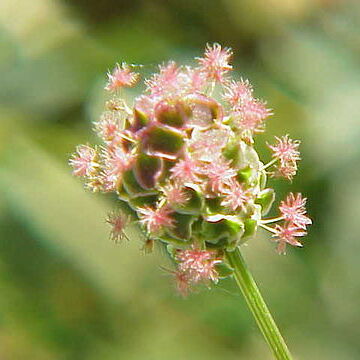Herbs perennial. Rootstock robust, bearing many fusiform, cylindric roots in lower part. Stipules sheathing, adnate to petiole, petiole sheathing and imbricate at base; leaf blade imparipinnate; leaflets serrate at margin. Inflorescences terminal on elongate scapes, densely capitate or spicate, bracteate and bracteolate. Flowers bisexual, rarely unisexual (when plants monoecious). Hypanthium with a constricted throat. Sepals 4(–7), imbricate, petaloid, purple, red, pink, or white, rarely greenish. Petals absent. Disk lining hypanthium. Stamens usually 4, rarely more, inserted in throat of hypanthium; filaments free, rarely partly connate; anthers didymous. Carpel 1(or 2), included in hypanthium; ovule pendulous; style terminal, filiform; stigma penicillate. Achene dry, included in hardened, muricate or winged hypanthium. Cotyledons planoconvex. x = 7.
Perennial herbs, often arising from thick, branching rhizomes. Lvs alternate, mostly in basal rosettes, imparipinnate; leaflets serrate; stipules persistent, adnate to petiole for lower ⅔. Fls in dense terminal clusters or spikes, subtended by several bracteoles, ☿ or unisexual, 4-merous, small, sessile. Hypanthium deeply concave. Epicalyx 0. Sepals greenish or purplish. Petals 0. Stamens 4-numerous. Ovary superior, surrounded by the hypanthium; carpels 1-2-(3); styles terminal and filiform; ovules solitary. Fr. of 1-(several) achenes enclosed in hardened, dry, 4-angled, sometimes ± flattened or cup-like hypanthium with variously sculptured faces and sometimes thickened or winged angles.
Fls 4-merous, perfect or unisexual; hypanthium urceolate, contracted at the mouth, ± 4-angled, not prickly; sep petaloid; pet none; stamens (2)4 or many; pistils 1 or 2; ovaries included in the hypanthium; ovule 1, suspended; style terminal; fr an achene, enclosed by the indurate hypanthium; perennial herbs from a thick rhizome, or annuals, the lvs pinnately compound with serrate to pinnatifid lfls, the fls small, borne in dense spikes or heads. 25, N. Amer., Eurasia.
Perennial herbs or shrubs, unarmed. Leaves often in rosettes, imparipinnate. Flowers in terminal spikes or heads on usually long and slender peduncles, 4-merous, bi-or unisexual. Hypanthium urceolate, constricted at apex, persistent. Sepals deciduous. Petals absent. Stamens 2-50. Pistils 1 or 2, rarely 3, free; ovaries 1-locular; style terminal, with peni-cillate stigma. Achenes included in hardened hypanthium.

